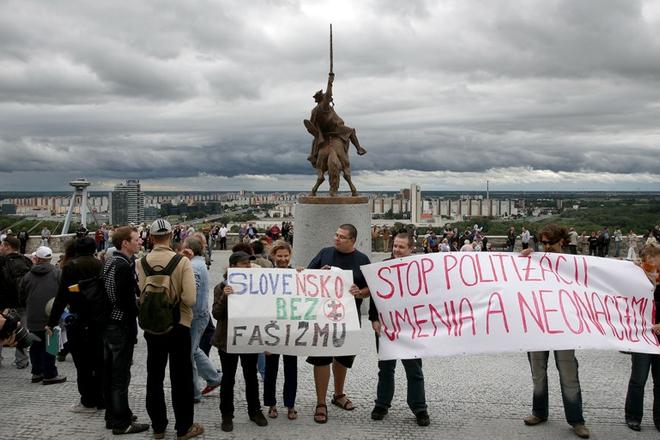WHEN former Prime Minister Robert Fico unveiled the statue of Svätopluk at Bratislava Castle shortly before the June 2010 parliamentary elections, he expressed a wish for the statue to become a destination for pilgrims to honour Slovak nationhood. The first pilgrimage, of sorts, came earlier than anyone expected as a group of about 60 right-wing extremists gathered in Bratislava to honour ‘King Svätopluk’ in a National Pilgrammage.
The group led by Michal Mišún was joined by Marián Kotleba, the former head of Slovenská Pospolitosť (Slovak Togetherness), an organisation disbanded for its past extreme activities, and the current leader of the Naše Slovensko (Our Slovakia) political party. The participants carried banners and Slovak and party flags and chanted slogans against the new ruling coalition and against Jews while marching through Bratislava’s Old Town, the SITA newswire reported.
The protesters' march was stopped by the municipal police at the entrance to Bratislava Castle as they did not have a permit to conduct their protest within the castle premises.
SITA reported that in their speeches Mišún and Kotleba criticized the current government and the SaS party for a purported intention to remove Svätopluk’s statue from the castle grounds, saying that Svätopluk is a symbol of Slovaks and Slovakia.
The police blocked the entry gate after participants started gathering in front of the castle. They said they wanted to come inside the castle grounds as individuals to pay tribute to Svätopluk. The police, however, dispersed the crowd while four persons wearing Naše Slovensko T-shirts remained constrained on the ground while the police detained Kotleba and several other persons. The police intervened shortly after the mayor of Old Town, Andrej Petrek, had asked the group to leave the castle area. Altogether 10 people were detained.
Protesting against violence
Meanwhile in the Bratislava Castle courtyard, about 50 people, mostly young, gathered at a previously-announced protest in response to the National Pilgrimage march and to speak against violence, Fascism, neo-Nazism, and the spreading of ideas oppressing human rights and freedoms. The action was organised by Robert Mihály of the imitative called UM!.
“Mr. Fico publicly announced that this statue should become a pilgrimage destination, which it indeed has become for the extremists and therefore I believe that Robert Fico carries a certain amount of responsibility,” Mihály said, as quoted by the Sme daily.
Mihály also read greetings from representatives of the NGOs People Against Racism, Man in Peril, and the initiative for Transparent Democracy and Intelligence. He ascribed the lower-than-expected attendance at the UM! event to the holiday season. The organisers had expected about 200 people to participate, SITA reported.
The recently unveiled statue of Svätopluk has raised questions among experts and the public regarding its historical accuracy, artistic value, and placement location. The UM! protest was originally expected to feature an expert discussion on whether it was a proper decision to place the statue at Bratislava Castle. However, this was cancelled as neither Jan Kulich, the sculptor of the statue, nor Fico who was the initiator of the idea to place Svätopluk’s statue at the castle, responded to invitations to attend.
Police try new tactics
All 150 members of Slovakia’s parliament also received an invitation to the event but the only MP to attend was Ondrej Dostál of the Civic Democratic Party (OKS), a member of the Most-Hid parliamentary caucus and a human rights activist. According to the Sme daily, Dostál appreciated the way police intervened.
Sme reported that the police used the occasion to practice new tactics of intervening in such demonstrations. The newly-appointed Police Corps President Jaroslav Spišiak told the daily that the police met with the organisers of the National Pilgrimage prior to their gathering and explained what would be considered an offence and what would be considered a crime. The new strategy also involved deploying certain police units only after the protesters clashed with municipal police officers, a measure that Spišiak said should limit the protesters’ feeling that “so many policemen came because of them”.
Spišiak said after the intervention that he was pleased with the performance of the police.
“It was the first attempt, it wasn’t 100 percent as I imagined it to be, but gradually it will improve,” Spišiak said, as quoted by Sme.
A similar extreme-right gathering was expected to occur on the following day, Sunday August 8. It was personally announced by Marián Kotleba at the municipal office of Šarišské Michaľany in eastern Slovakia to commemorate exactly one year after what the extremists called a ‘gathering against Roma terror’ that took place in the village in 2009. The SITA newswire reported that the planned gathering was cancelled, however.



 About 50 people gathered at a protest against violence, Fascism, neo-Nazism, and the spreading of ideas oppressing human rights. (source: Sme - Tomáš Benedikovič)
About 50 people gathered at a protest against violence, Fascism, neo-Nazism, and the spreading of ideas oppressing human rights. (source: Sme - Tomáš Benedikovič)